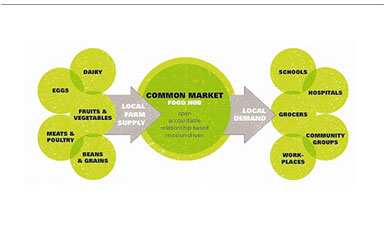by Rona Fried
For the first time, institutional investors will be able to invest in agricultural infrastructure and rural communities in the US.
Now open for business, the Rural Infrastructure Opportunity Fund enables pension funds, foundations and other large investors to invest in everything from rural hospitals, schools and educational facilities to broadband expansion, rural water and wastewater systems, energy projects and local and regional food infrastructure.
"Meeting the world’s needs for food and farm products, as well as the growing demand in areas like renewable energy, local food, and the bioeconomy will require continued investment in rural places," says Tom Vilsack, Secretary of Agriculture (USDA). "Many major investors in urban centers aren’t always aware of the significant investment opportunities in rural communities. If the White House Rural Council can help facilitate even a small portion of the enormous amount of available investment capital into rural places, we can grow key industries and create jobs in rural and urban areas from coast to coast."
CoBank, a national cooperative bank that serves rural America, is the anchor investor, committing an initial $10 billion in seed capital. Capitol Peak Asset Management will manage the fund and recruit more investors.
USDA and other federal agencies will act as matchmakers, identifying worthy projects for funding.
This is a new role for USDA, says Vilsack, who also Chairs the White House Rural Council. "USDA and other agencies invest in infrastructure through a variety of federal initiatives, but our resources are finite and there are backlogs of projects in many parts of the economy. We know where investment opportunities exist, so we are in a position to help promote these projects among investors. With new efforts like this we can move beyond existing programs."
It’s a win-win with strong demand on both sides of the equation – investors want yields and rural communities have lots of projects.
In some cases, private investors will fund entire projects and in others their money will add critical dollars to government loan and grant programs. Investments can based on debt or equity and can be in individual or bundled projects.
Earlier this year, USDA launched a $150 million Rural Business Investment Company which facilitates private equity investments in innovative agriculture-related businesses.
USDA Food Hubs Successful
Thanks to USDA’s food hubs – launched with $25 million two years ago – a growing network is connecting local farms with hospitals, schools, restaurant chains and grocery stores.
Entrepreneurs and nonprofits deliver farm-fresh food directly to institutions, freeing them from relying solely on huge, amorphous food service companies which provide mostly processed food.
In Philadelphia, Thomas Jefferson University Hospital, for example, now serves locally grown food from Common Market food hub, reports Associated Press. Foods include free range eggs and meat, home-made yogurt and vegetables like bok choy, asparagus and spinach.

Common Market picks up food from 75 local farmers and small food companies and distributes it to 220 customers. The nonprofit’s revenue has grown from $125,000 in 2008 to more than $2.5 million this year and all the money is reinvested, reports Associated Press. USDA gave them a $300,000 grant last year to improve access to healthier foods in low-income communities.
Other examples are New York City’s Greenmarket Company and Detroit’s Eastern Market. USDA’s role is to give grants and microloans to hubs and farmers, along with technical support and equipment.
These hubs are essential because institutions go through a lot of food. They don’t have staff or time to visit individual farms and pick out produce. And until now, small farmers haven’t had a way to sell their crops in bulk.
For USDA, it’s a step in the right direction away from its traditional emphasis on big agriculture commodity crops such as soybeans and corn. Even now, fruits and vegetable growers aren’t eligible for the same subsidies that agribusiness gets. The effort has thus far spawned 300 food hubs in the US.
Even without subsidies, growing fruits and vegetables – especially organic – have much bigger margins than commodity crops. For an acre of field corn (for ethanol, animal feed and corn syrup), Plains state farmers earn just $284 after expenses, compared to at least $2000 for apples, reports the NY Times. "A sophisticated vegetable operation using the popular plastic covers called high tunnels, which increase yields and extends the growing season, can push that figure as high as $100,000," they say.
And food hubs are making this a reality for more and more farmers by giving them the means to sell locally.
"The children of corn farmers are coming back to the farm, and carving out 5 or 10 acres to grow fruits and vegetables," Craig Chase, local food and farm coordinator at Iowa
State University, told the NY Times. "They can easily make $30,000 to $40,000 a year."
It all began in 2009 when USDA launched "Know Your Farmer, Know Your Food." Since then it’s been involved with about 3000 projects that help small farms.
In 2012, USDA gave out grants that bring local food to 3,200 schools in 37 states. "When schools buy food from nearby producers, their purchasing power helps create local jobs and economic benefits, particularly in rural agricultural communities," says Kathleen Merrigan, Deputy Secretary at USDA. "Evidence also suggests that when kids understand more about where food comes from and how it is produced, they are more likely to make healthy eating choices."
Read our article, Locally Produced Food Gets Boost Through Food Hubs.
Read the NY Times article, The Seeds of a New Generation:
